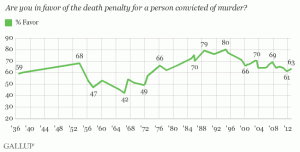Gallup has released its latest numbers on public opinion about the death penalty:
Americans’ support for the death penalty as punishment for murder has plateaued in the low 60s in recent years, after several years in which support was diminishing. Sixty-three percent now favor the death penalty as the punishment for murder, similar to 61% in 2011 and 64% in 2010.
Although views on the death penalty have been fairly static since 2010, support has been gradually diminishing since the high point in 1994, when 80% were in favor. By 2001, roughly two-thirds were in favor, and since then it has edged closer to 60%.
Correlation does not imply causation, but it’s interesting to compare the trends in public opinion about the death penalty with trends in the violent crime rate. Here’s Gallup’s chart of public support for the death penalty according to its polling from 1936 to 2012:
If you look closely at that chart from around 1960 to the present — and you might need to click on it to see it better — you see the upward trend until around the mid-1990s, and then a decline since then. Compare that trend to this chart of violent crime rates in the United States (in violent crimes per 100,000 people) since 1960:
The violent crime rate looks somewhat familiar: It rose until the mid-1990s and then declined. Again, correlation is not causation, and this is just speculation. But I wonder if the change in public opinion on the death penalty partially reflects changing violent crime rates. Higher crime rates might mean more fear of crime and a marginal increase in who favors capital punishment, and lower crime rates might mean less fear or crime and less of a sense that the death penalty is necessary.
Thanks to How Appealing for the link to the latest Gallup numbers.

